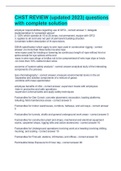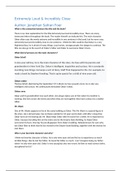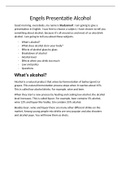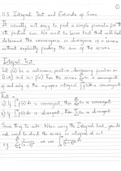Medical Pharmacology Book Notes
Chapter 1: Intro Medicines
Doctrine of signature: the Creator who arranged the forces of nature created certain
signs (signa) so the forces could be found. This explains the similarity between plant
and illness, e.g., heart-shaped fruits or plants are for the heart, the roots are for the
feet.
Contrario-rule: the illness needs to be counteracted or removed (Galenus).
The similia-rule is reflected in the view that the plant that causes illness is the plant
that cures (homeopathy).
Pharmacotherapy frequently leads to iatrogenic (caused by doctor) symptoms of
disease.
It is generally thought that there is a certain hypersensitivity (idiosyncrasy ->
variability of a person) involved. This can be of an allergic nature for instance.
Placebo = I will please, occur on average 30%, can be up to 70%.
During development of new drugs potential carcinogenic (cancer-causing),
mutagenic (mutation inducing) and teratogenic (‘monster’ forming = embryo
damaging) effects must also be investigated.
The different phases of drug development:
1. Phase I: healthy volunteers are used to test tolerance and pharmacokinetics.
2. Phase II: Same range finding studies are performed on patients.
3. Phase III: If approved, a clinical study may be conducted on patients, in which the
therapeutic effect of the new compound is compared to an existing drug and/or
placebo -> Controlled clinical trial.
The principal ethical standards:
1. The individual patients must not be placed at risk of getting an inferior
treatment.
2. The patient must, after having been provided with information, without
coercion, give his/her permission (informed consent).
3. Risk to the patient must not be (significantly) greater than those of standard
treatment.
Pharmacodynamics: what does the drug do with the body.
Pharmacokinetics: what does the body do with the drug.
Drugs are intended to have a selective action, but this ideal is seldom achieved.
There is always a risk of adverse effects as well as a benefit connected with using any
drug.
Nocebo: a placebo with adverse effects.
Chapter 2: Drug dose-effect and receptor theory
The molecular structure of the drug determines whether and to what extent, an
interaction with the relevant receptors is possible, in other words, if the substance
‘fits on the receptor’.
In some cases, the action of drugs, is not the result of an interaction with cells, but
due to a ‘simple’ chemical reaction or physical process. Drugs such as chemotherapy
, drugs and antibiotics that attach to pathogenic microorganisms that might be
present in the body.
An agonist activates the relevant receptors, while antagonists reduce the effect.
Receptor activation can result in: local conformation-changes in cell membrane,
altering permeability to certain ions, or activity changes of membrane-bound
enzymes. These primary effects of receptor activation can then lead to further
changes in various intracellular processes and will eventually result in a response by
tissue(s) or organ(s).
A specific drug is defined as a compound that causes its effect by only one single
mechanism of action (one particular type of receptors). In practice, no drug seems to
be able to comply with this condition, however, drugs can be highly selective in their
action -> many drugs, in relatively low doses, will primarily only bind to one
particular type of receptor and only activate other receptors at much higher doses.
Receptor theory is based on the following premises:
a. Drug and receptor ‘recognize’ each other: in other words, the drug has affinity
for the receptor (corresponds to the molecular structure).
b. Occupancy postulate: the magnitude of the effect of a drug depends on the
number of receptors bound by the drug at a particular concentration, in other
words, the fraction or the percentage of the total available number of receptors,
that is occupied by the drug-molecules.
c. the interaction between drug and receptor is reversible and takes place at a 1:1
ratio (biomolecular reaction).
d. Drug-concentration is so high compared to the receptor ‘concentration’, that the
former is not significantly affected by binding of drug-molecules to the receptors.
The concentration, at which 50% of the maximum effect of that drug is found, is
equal to the dissociation constant of the drug-receptor complex involved.
The affinity of an agonist for a particular receptor is expressed as its pD 2-value. The
greater the pD2-value of the agonist, the greater the affinity for its receptors will be.
Despite having the same degree of receptor occupancy, the biological efficacy of an
agonist-receptor complex can differ, depending on so-called intrinsic activity () of
the agonists.
Agonists with =1 are called full agonists, agonists with <1 are called partial
agonists. Both properties are however typically attributable to different parts of the
molecule.
A competitive antagonist B binds in a reversible way to the receptors and thus
counteracts the effect of agonist A to a greater or lesser extent, dependent on the
concentration of A and B, their affinity for the receptors involved and their intrinsic
activities. An essential factor related to competitive antagonism is that it can be
overcome by increasing the agonist concentration.
Full antagonist for which intrinsic activity is represented as =0, partial antagonists
for which 0<<1 applies.
The affinity of full competitive antagonists is expressed pA2-value.
In case of functional antagonism, both receptors are present in the same tissue
(possibly the same culls).
In case of physiological antagonism both receptor systems are located in separate
tissue or organs.
Chapter 1: Intro Medicines
Doctrine of signature: the Creator who arranged the forces of nature created certain
signs (signa) so the forces could be found. This explains the similarity between plant
and illness, e.g., heart-shaped fruits or plants are for the heart, the roots are for the
feet.
Contrario-rule: the illness needs to be counteracted or removed (Galenus).
The similia-rule is reflected in the view that the plant that causes illness is the plant
that cures (homeopathy).
Pharmacotherapy frequently leads to iatrogenic (caused by doctor) symptoms of
disease.
It is generally thought that there is a certain hypersensitivity (idiosyncrasy ->
variability of a person) involved. This can be of an allergic nature for instance.
Placebo = I will please, occur on average 30%, can be up to 70%.
During development of new drugs potential carcinogenic (cancer-causing),
mutagenic (mutation inducing) and teratogenic (‘monster’ forming = embryo
damaging) effects must also be investigated.
The different phases of drug development:
1. Phase I: healthy volunteers are used to test tolerance and pharmacokinetics.
2. Phase II: Same range finding studies are performed on patients.
3. Phase III: If approved, a clinical study may be conducted on patients, in which the
therapeutic effect of the new compound is compared to an existing drug and/or
placebo -> Controlled clinical trial.
The principal ethical standards:
1. The individual patients must not be placed at risk of getting an inferior
treatment.
2. The patient must, after having been provided with information, without
coercion, give his/her permission (informed consent).
3. Risk to the patient must not be (significantly) greater than those of standard
treatment.
Pharmacodynamics: what does the drug do with the body.
Pharmacokinetics: what does the body do with the drug.
Drugs are intended to have a selective action, but this ideal is seldom achieved.
There is always a risk of adverse effects as well as a benefit connected with using any
drug.
Nocebo: a placebo with adverse effects.
Chapter 2: Drug dose-effect and receptor theory
The molecular structure of the drug determines whether and to what extent, an
interaction with the relevant receptors is possible, in other words, if the substance
‘fits on the receptor’.
In some cases, the action of drugs, is not the result of an interaction with cells, but
due to a ‘simple’ chemical reaction or physical process. Drugs such as chemotherapy
, drugs and antibiotics that attach to pathogenic microorganisms that might be
present in the body.
An agonist activates the relevant receptors, while antagonists reduce the effect.
Receptor activation can result in: local conformation-changes in cell membrane,
altering permeability to certain ions, or activity changes of membrane-bound
enzymes. These primary effects of receptor activation can then lead to further
changes in various intracellular processes and will eventually result in a response by
tissue(s) or organ(s).
A specific drug is defined as a compound that causes its effect by only one single
mechanism of action (one particular type of receptors). In practice, no drug seems to
be able to comply with this condition, however, drugs can be highly selective in their
action -> many drugs, in relatively low doses, will primarily only bind to one
particular type of receptor and only activate other receptors at much higher doses.
Receptor theory is based on the following premises:
a. Drug and receptor ‘recognize’ each other: in other words, the drug has affinity
for the receptor (corresponds to the molecular structure).
b. Occupancy postulate: the magnitude of the effect of a drug depends on the
number of receptors bound by the drug at a particular concentration, in other
words, the fraction or the percentage of the total available number of receptors,
that is occupied by the drug-molecules.
c. the interaction between drug and receptor is reversible and takes place at a 1:1
ratio (biomolecular reaction).
d. Drug-concentration is so high compared to the receptor ‘concentration’, that the
former is not significantly affected by binding of drug-molecules to the receptors.
The concentration, at which 50% of the maximum effect of that drug is found, is
equal to the dissociation constant of the drug-receptor complex involved.
The affinity of an agonist for a particular receptor is expressed as its pD 2-value. The
greater the pD2-value of the agonist, the greater the affinity for its receptors will be.
Despite having the same degree of receptor occupancy, the biological efficacy of an
agonist-receptor complex can differ, depending on so-called intrinsic activity () of
the agonists.
Agonists with =1 are called full agonists, agonists with <1 are called partial
agonists. Both properties are however typically attributable to different parts of the
molecule.
A competitive antagonist B binds in a reversible way to the receptors and thus
counteracts the effect of agonist A to a greater or lesser extent, dependent on the
concentration of A and B, their affinity for the receptors involved and their intrinsic
activities. An essential factor related to competitive antagonism is that it can be
overcome by increasing the agonist concentration.
Full antagonist for which intrinsic activity is represented as =0, partial antagonists
for which 0<<1 applies.
The affinity of full competitive antagonists is expressed pA2-value.
In case of functional antagonism, both receptors are present in the same tissue
(possibly the same culls).
In case of physiological antagonism both receptor systems are located in separate
tissue or organs.










